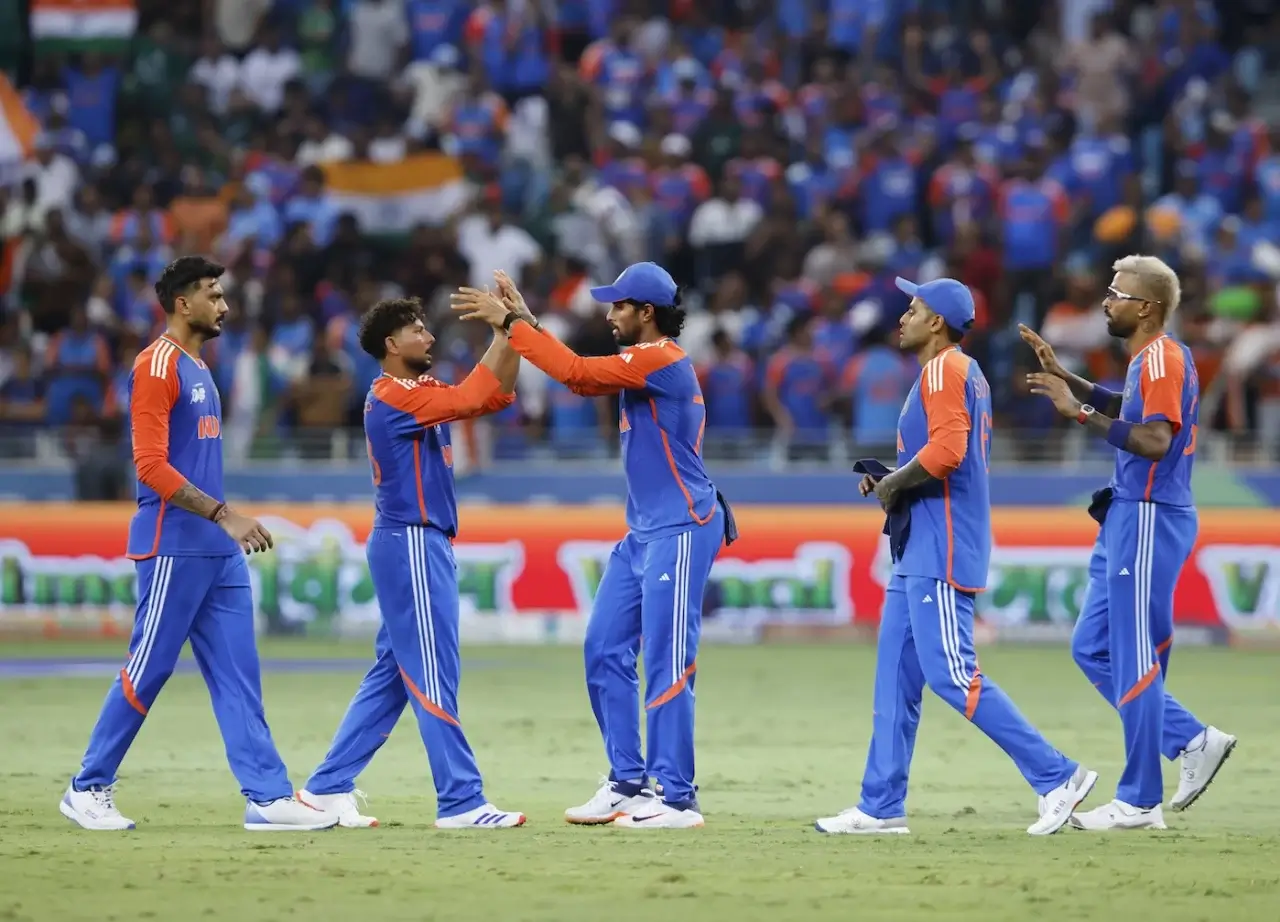India’s Asia Cup campaign has combined tactical risk with workload planning. Jasprit Bumrah is bowling three overs in the powerplay and another at the death. This role is physically demanding and rarely given to a bowler in T20 internationals. Yet, India believes Bumrah’s unique skills make him ideal for the job.
Assistant coach Ryan ten Doeschate has defended this approach. He called Bumrah’s workload “an exceptionally tough job” but also the right move for team balance. Bumrah’s numbers look modest so far, with three wickets in three games and an economy of 8.36. But the management values his ability to control phases that often decide matches.
Another major shift is Sanju Samson’s trial at No.5. He top-scored against Oman with 56 but looked less secure against Pakistan. The team believes Samson has the tools to succeed in this role. His adaptation could give India more stability in the middle overs.
India is also mindful of the upcoming Test series against West Indies. The Asia Cup has doubled as workload preparation for Bumrah and others. The balancing act between short-term T20 tactics and long-term Test planning defines India’s approach.
India’s unique powerplay role and why it matters

Jasprit Bumrah’s deployment in the powerplay is no accident. India wants early control and relies on his accuracy to restrict scoring. By bowling three overs upfront, Bumrah forces opposition openers into riskier strokes. This approach reduces boundary opportunities and can create early breakthroughs, like England does in their matches.
The strategy is also rare. In T20 internationals, bowlers usually deliver two overs in the first six. Bumrah last bowled three powerplay overs in 2019, highlighting how unusual this current role is. Combining three powerplay overs with a death over puts heavy strain on any bowler.
Yet the rewards are clear. With runs squeezed early, India can unleash its spinners in the middle overs. Bumrah’s pressure up front allows spinners to attack when batters are already under stress. Even when wickets don’t fall, Bumrah builds scoreboard pressure. That pressure benefits the team overall, even if his economy rate rises.
Coaches understand this workload is demanding. They view it as both a short-term tactic and useful preparation for the upcoming Test series. Bumrah’s role is as much about today’s wins as it is about tomorrow’s fitness.
Key numbers behind Bumrah’s workload
Bumrah has bowled 11 overs in this Asia Cup so far. He was rested against Oman but has otherwise delivered three overs in the powerplay and one at the death. Ten Doeschate described the role as “quite strenuous” but the right call for the team.
This plan produces mixed outcomes. Some matches bring wickets and control, others bring runs conceded. The management accepts this inconsistency because the overall balance works. They remain committed to using Bumrah this way unless India secures qualification early.
The tactical benefits and risks of India’s approach
India’s frontloading of Bumrah creates both opportunities and vulnerabilities. On the positive side, it unsettles top orders and limits quick scoring. Opponents who rely on fast starts are forced to rethink their strategy. That early disruption helps India dictate the tempo of matches.
The strategy also fits India’s spin-heavy attack. By using Bumrah early, India reduces the need for multiple seamers. Spinners can then take over during the middle overs, often with batters under pressure. This creates a layered bowling plan that adapts across phases.
However, the risks are real. Bumrah sometimes goes wicketless and concedes heavily, especially when batters attack his third powerplay over. India’s reliance on him up front can also leave fewer options late in the innings. It’s a high-reward but high-risk setup.
Coaches accept these trade-offs. They see it as the best fit for India’s current balance. With Tests on the horizon, Bumrah’s workload also doubles as preparation. The management remains firm: match control matters more than individual figures.
How Bumrah’s early overs change match dynamics?
Frontloading Bumrah forces batters to adjust their tempo. Boundaries become harder, and dot-ball pressure builds quickly. That makes spinners’ jobs easier in the middle overs, where containment turns into wicket-taking.
Teams banking on aggressive starts are most affected. They face higher risks against Bumrah and often fall behind the required rate. India uses this advantage to tilt close contests in its favour. The plan may not always bring wickets, but it often wins control.
Sanju Samson at No.5: promise, pressure, and potential
Sanju Samson’s shift to No.5 has become one of the talking points of India’s campaign. He has usually thrived at the top, both in international cricket and the IPL. At No.5, the role is different. It requires reading situations, rebuilding innings, and accelerating late.
His first chance came in a dead rubber against Oman. On a slow wicket, Samson top-scored with 56 off 45, showing composure. Against Pakistan, he struggled, scoring 13 off 17 before falling to Haris Rauf. These two outings underline the adjustment period he faces.
Selectors believe Samson has the skill set to master this role. His ability to rotate strike and play big shots makes him a strong candidate. If he adapts, India gains flexibility in its middle order, which has often lacked stability. Samson’s success could reduce pressure on finishers and anchor India’s batting plans.
How Samson can master the No.5 role?
Succeeding at No.5 requires balancing patience with aggression. Samson must rotate the strike early, then switch gears later. Reading the bowlers and adjusting to pitch wear will be key. Clear game awareness will help him build innings under pressure.
Selectors value his touch and power, especially in overs 10–16. If he clicks, India’s batting gains depth and stability. A reliable No.5 also frees others to play their natural roles. Samson’s adaptation could prove as vital as Bumrah’s workload in shaping India’s campaign.
Bench strength dilemma: Jitesh and Rinku waiting in the wings
India’s bench has yet to feature in the Asia Cup. Players like Jitesh Sharma and Rinku Singh remain unused. The reason is simple: the format allows little room for experimentation. With only four Super Four games, even two wins don’t guarantee qualification.
Management believes bilateral series are better for testing new players. Asia Cup games are too high-stakes for rotation. As a result, bench players are limited to training and preparation. That means fewer opportunities for selectors to evaluate their readiness under pressure.
Still, bench strength remains crucial for long-term plans. Injuries or form slumps can force sudden changes. Keeping Jitesh and Rinku match-ready ensures smooth transitions. Their chance may come in upcoming bilateral matches, where flexibility can be tested without tournament risks.
What India loses by not using its bench
By not rotating, India loses the chance to test flexibility. Players like Rinku Singh could provide finishing options. Jitesh Sharma offers wicketkeeping depth and explosive hitting. Missing out on such trials delays decisions for bigger tournaments.
The management accepts this limitation. For now, they prioritise qualification over experimentation. The focus is on winning, with trials left for later tours. It is a calculated compromise, but one that may cost India valuable insights.
India vs Bangladesh: the rivalry shaping Asia Cup fate
India’s next big clash is against Bangladesh. Both teams won their first Super Four game. The winner of this match gains a clear path to the final. The stakes make this encounter a high-pressure battle for both sides.
Bangladesh have adapted well to modern T20 styles. They now rely on aggressive openers and bold batting approaches. India’s coaching staff acknowledges their rise but insists on staying focused on processes. Respect is given, but no fear is shown.
For India, the match is about execution. Bumrah’s powerplay overs, Samson’s role at No.5, and smart fielding will be key. If these elements click, India should remain favourites. The contest adds another chapter to a growing regional rivalry.
For history lovers, here’s a detailed look at the India vs Bangladesh timeline that captures past encounters: India vs Bangladesh Rivalry.
Match keys: how India can beat Bangladesh
India must win the early overs with Bumrah’s control and spin pressure. A steady No.5 contribution from Samson will prevent collapses. Strong death-overs execution, both batting and bowling, will decide the contest.
Bangladesh will push with aggressive starts, but disciplined Indian bowling can counter them. Fielding sharpness and middle-order stability will be the final difference. The team handling pressure better will likely reach the Asia Cup final.
Conclusion: India’s Asia Cup approach under the spotlight
India’s Asia Cup strategy combines risk and preparation. Bumrah’s workload is demanding, but it brings control in crucial overs. Though not always reflected in his stats, his impact is undeniable. The team sees his role as both match-winning and Test-preparing.
Samson’s move to No.5 remains a work in progress. His innings against Oman showed promise, but Pakistan exposed the challenges. Selectors remain confident he can adjust, bringing depth and flexibility to the middle order.
The bench dilemma shows India’s caution in this short tournament. Jitesh and Rinku wait, while proven names take the field. Their time will likely come in bilateral series, where risks are lower.
India’s clash with Bangladesh will be decisive. A win secures a path to the final, while a loss creates pressure. With Bumrah’s control and Samson’s growth, India hopes to shape its destiny. Tactical clarity, smart rotation, and adaptability will decide whether India lifts the Asia Cup.

